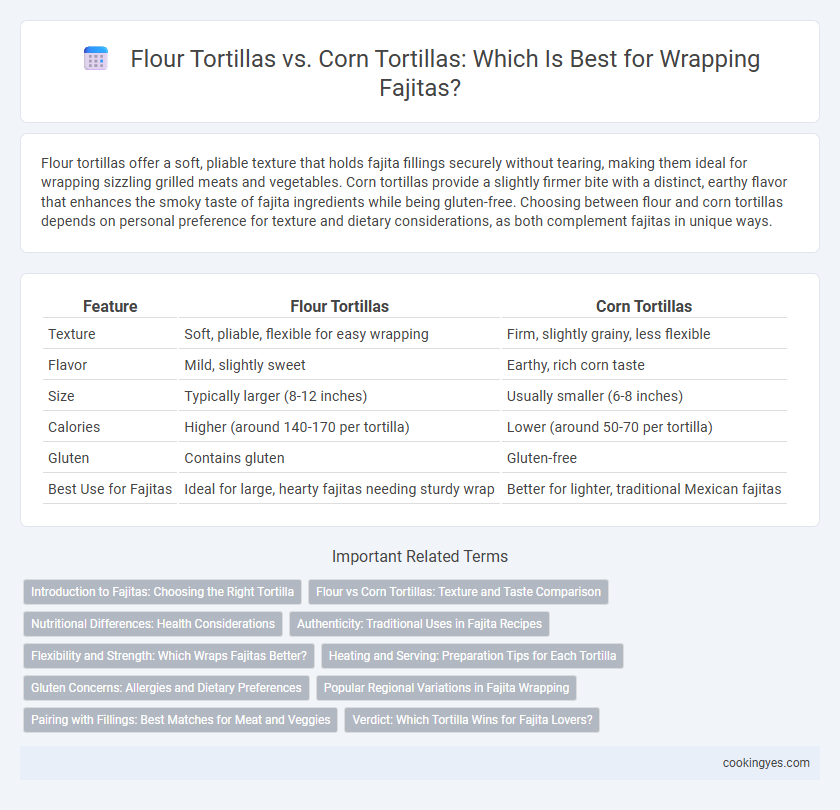Flour tortillas offer a soft, pliable texture that holds fajita fillings securely without tearing, making them ideal for wrapping sizzling grilled meats and vegetables. Corn tortillas provide a slightly firmer bite with a distinct, earthy flavor that enhances the smoky taste of fajita ingredients while being gluten-free. Choosing between flour and corn tortillas depends on personal preference for texture and dietary considerations, as both complement fajitas in unique ways.
Table of Comparison
| Feature | Flour Tortillas | Corn Tortillas |
|---|---|---|
| Texture | Soft, pliable, flexible for easy wrapping | Firm, slightly grainy, less flexible |
| Flavor | Mild, slightly sweet | Earthy, rich corn taste |
| Size | Typically larger (8-12 inches) | Usually smaller (6-8 inches) |
| Calories | Higher (around 140-170 per tortilla) | Lower (around 50-70 per tortilla) |
| Gluten | Contains gluten | Gluten-free |
| Best Use for Fajitas | Ideal for large, hearty fajitas needing sturdy wrap | Better for lighter, traditional Mexican fajitas |
Introduction to Fajitas: Choosing the Right Tortilla
Flour tortillas offer a soft, pliable texture that complements the smoky, seasoned fillings of fajitas, making them ideal for wrapping grilled meats and vegetables. Corn tortillas provide a traditional, slightly firmer base with a distinct corn flavor, enhancing the authenticity of Mexican-style fajitas. Selecting the right tortilla depends on personal preference and the desired balance between texture and taste in fajita presentation.
Flour vs Corn Tortillas: Texture and Taste Comparison
Flour tortillas offer a soft, chewy texture that complements the sizzling, juicy fillings of fajitas, enhancing the overall mouthfeel with a subtle, slightly sweet flavor. Corn tortillas provide a firmer, more rustic bite with a pronounced corn taste that adds an earthy dimension, often preferred for traditional fajita wraps. Choosing flour tortillas creates a pliable wrap ideal for folding, while corn tortillas bring an authentic, grainy texture, influencing the fajita's flavor profile and dining experience.
Nutritional Differences: Health Considerations
Flour tortillas typically contain more calories and carbohydrates compared to corn tortillas, making corn tortillas a lower-calorie option suitable for weight management. Corn tortillas provide higher fiber content and essential nutrients like magnesium and phosphorus, promoting digestive health and bone strength. Individuals with gluten intolerance should choose corn tortillas, as they are naturally gluten-free, while flour tortillas may contain gluten and additives.
Authenticity: Traditional Uses in Fajita Recipes
Corn tortillas hold a strong place in authentic fajita recipes, as they are traditionally used in Mexican cuisine for their earthy flavor and sturdy texture, which complements grilled meats and vegetables. Flour tortillas, although more popular in Tex-Mex adaptations, offer a softer and more pliable wrap but diverge from the original fajita preparation techniques rooted in Mexico. Authentic fajitas typically showcase corn tortillas to preserve the cultural heritage and enhance the overall taste experience aligned with traditional cooking methods.
Flexibility and Strength: Which Wraps Fajitas Better?
Flour tortillas offer superior flexibility and strength, making them ideal for tightly wrapping fajitas without tearing. Corn tortillas tend to be more brittle and less pliable, which can cause cracking under the weight and moisture of fajita fillings. For a more durable and cohesive fajita wrap, flour tortillas outperform corn tortillas in maintaining structure and preventing spills.
Heating and Serving: Preparation Tips for Each Tortilla
Flour tortillas soften evenly and remain pliable when heated on a skillet or wrapped in foil, making them ideal for wrapping sizzling fajita fillings without cracking. Corn tortillas benefit from a quick, direct heat treatment on a dry skillet to enhance their flavor and flexibility, preventing brittleness and tearing during serving. For best results, warm flour tortillas covered to retain moisture and heat corn tortillas briefly on each side just before assembling fajitas.
Gluten Concerns: Allergies and Dietary Preferences
Flour tortillas contain gluten, making them unsuitable for individuals with celiac disease or gluten sensitivity, whereas corn tortillas are naturally gluten-free and ideal for those with gluten allergies or dietary restrictions. Corn tortillas also offer a more authentic Mexican flavor profile, enhancing the traditional fajita experience while accommodating gluten-intolerant diners. For health-conscious consumers and allergy management, choosing corn tortillas ensures safe consumption without compromising taste or texture.
Popular Regional Variations in Fajita Wrapping
Flour tortillas dominate fajita wrapping in Tex-Mex cuisine, favored for their soft texture and large size, which accommodates grilled meats and sauteed vegetables. In contrast, corn tortillas are prevalent in traditional Mexican regions like northern Mexico, offering a distinct corn flavor and a slightly firmer texture that complements spiced fillings. Regional preferences often reflect cultural roots, with flour tortillas preferred in U.S. border states and corn tortillas celebrated in authentic Mexican fajita preparations.
Pairing with Fillings: Best Matches for Meat and Veggies
Flour tortillas offer a soft, pliable texture ideal for wrapping juicy grilled meats like steak or chicken, complementing fajita fillings with their mild, slightly sweet flavor. Corn tortillas provide a firmer, more rustic base that pairs well with vegetable-heavy fajitas, such as sauteed peppers, onions, and mushrooms, enhancing the smoky, earthy taste of plant-based ingredients. Choosing between flour and corn tortillas depends on the desired balance of texture and flavor, optimizing the overall fajita experience by matching the wrap to the primary fillings.
Verdict: Which Tortilla Wins for Fajita Lovers?
Flour tortillas are the preferred choice for fajita lovers due to their soft, pliable texture that holds up well to fillings and grilling, enhancing the overall flavor experience. Corn tortillas offer a traditional, slightly smoky taste and a gluten-free option but tend to be less flexible and prone to cracking when wrapped around fajita ingredients. For durability, taste, and versatility in fajita preparation, flour tortillas generally win the verdict among enthusiasts.
Flour tortillas vs Corn tortillas for Fajita wrapping Infographic

 cookingyes.com
cookingyes.com